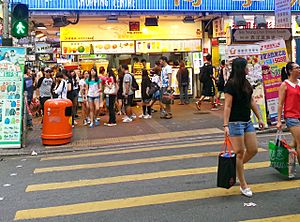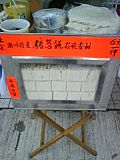Hong Kong street food facts for kids

Hong Kong street food means tasty snacks and drinks sold by vendors on the streets. These foods are ready to eat right away! Some popular examples include egg tarts, fish balls, egg waffles, and stinky tofu. You can find these yummy treats all over Hong Kong. Look for them especially in areas like Mong Kok, Causeway Bay, and Tsuen Wan.
What Makes Hong Kong Street Food Special?
Street food is super convenient. You can grab it and eat it instantly, often while walking! Usually, you get your snacks in a simple box with bamboo sticks or plastic forks. Even though many street food places are now shops, they still keep the "grab-and-go" style. The food is made very quickly, so you don't have to wait long.
Some experts say street food might use more oil, sugar, or salt than other foods. But it's still a delicious part of Hong Kong's culture! In 2013, street food prices were usually between $1 and $25. This made them very popular and affordable for people in Hong Kong.
Street food stalls offer many different snacks. You can find local favorites like red-bean pudding. You might also find international treats like Thai prawn cutlets. This shows how diverse Hong Kong's food scene is!
The Story of Hong Kong Street Food
Early Snack Sellers
People have been selling food on the streets for a long time. Even back in the Tang Dynasty, hawkers sold cold food to help people cool down in summer. Later, during the Qing dynasty, street snack stalls grew into busy street markets. Old stories tell of hawkers carrying wooden barrels and stoves. This shows how street snacks became a part of Hong Kong's history.
Street Food Grows in the 1900s
In the 1950s, Hong Kong faced tough economic times. Many people didn't have jobs. So, lots of people became street hawkers to earn a living. They used simple setups like rough canopies and wooden carts. They sold snacks from mobile carts on main streets to reach more customers.
After World War II, many people moved to Hong Kong from Mainland China. Around 300,000 of them became hawkers, including street food sellers. This helped street food culture grow a lot. These hawkers mostly served people with lower incomes. Their stalls were often "junkers," which were wooden carts with wheels. This allowed them to be pushed around easily. The food was cheap and came in many varieties. Street food became very popular in the 1950s and 1960s.
Later, the Hong Kong government wanted to make the city cleaner. So, they started to ban these mobile stalls. Many hawkers then opened their businesses in shops instead. Even though the way they sell food changed, the types of delicious snacks stayed the same!
Changes in Modern Times
From the 1970s to the 1980s, several things caused street snacks to change.
Government Rules and Policies
In the 1970s, the government became stricter with hawkers. Before, they had a more relaxed approach. For example, they stopped giving out new hawker licenses in 1979. This was to control the number of stalls. Later, in 1995, city councils even tried to get rid of hawkers. These actions made it harder for street food to be as common as before.
Focus on Cleanliness
People started to worry more about hygiene. Some street snacks were found to have germs. A government video in 1987 showed concerns about food stalls. It showed a hawker smoking and a stall near a busy road with a wet, dirty floor. These hygiene worries made customers think twice. This pushed for changes in how street food was prepared and sold.
Social Changes and Community Life
After the 1950s, many people came to Hong Kong during difficult times. Most of them were not highly educated. So, they found ways to earn money on the streets. This included selling food, singing, and telling stories.
The 1960s and 1970s were a golden age for hawkers. More than 300,000 people worked in this industry. This was about 20% of all workers! Back then, there weren't many shopping malls or markets. This gave hawkers many chances to grow their businesses.
Over time, hawkers started to want a better quality of life. Sometimes, crowds around hawker carts caused problems for people walking by. There were also safety concerns. For example, elderly people might slip on puddles. Children could get hurt by hot oil from the stalls. These concerns made some people unhappy with street hawkers.
How Street Food Has Changed Today
Over the last few decades, Hong Kong street food has changed how it operates.
New Laws and Licenses
The government now limits the number of hawker licenses. By 2011, there were only 233 licenses for fixed stalls and 93 for mobile hawkers. This is much less than in 2005, when there were 1,075 fixed stall licenses. To keep things safe and clean, the government also controls hawking through laws.
Better Hygiene
Today, street food is kept boiling hot to stop bacteria from growing. This helps make sure the food is safe to eat.
Different Ways of Selling Food
Because there are fewer mobile licenses, many hawkers now have fixed spots, often inside shopping malls. Before, street snacks were found all over Hong Kong. Now, they are mostly in six main districts. These include Eastern, Central and Western, Wan Chai, Yau Tsim Mong, Sham Shui Po, and Kowloon City.
Why Street Food Matters to Hong Kong
A Boost for Tourism and Global Fame
Hong Kong's street snacks are famous worldwide! This helps bring tourists to the city. The Hong Kong Tourism Board even calls street food a "must-eat." CNN Travel has a special section just for Hong Kong street snacks. In 2013, an online travel advisor ranked Hong Kong first among the top 10 street-food cities. All this recognition makes Hong Kong people proud of their street food culture.
Showing Hong Kong's Values
Street snacks show Hong Kong's diverse culture. You can find stalls selling foreign treats like Takoyaki and Indonesian skewers. This wide variety of choices proves why Hong Kong is called a "Gourmet Paradise." Even with all the changes, street food still represents Hong Kong's identity. For example, "Hong Kong style Egg Waffle" shows its local roots. The way street food changes and adapts shows Hong Kong's openness to new things. It also helps share its unique character with the world.
In 2015 and 2016, some local groups supported street vendors. They felt that vendors, who are often less wealthy, were being treated unfairly by the government. This led to some protests and clashes. These events showed how important street vendors are to some people in Hong Kong.
Popular Hong Kong Street Foods
| Name | Image | Description |
|---|---|---|
| Fishballs
魚蛋 |
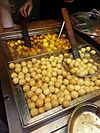 |
Fishballs are usually served in curry sauce. They are often sold on a skewer. |
| Siu mai
燒賣 |
 |
These are different from the ones in Chinese restaurants. They are usually made only with fish meat and pork. |
| Imitation shark fin soup
碗仔翅 |
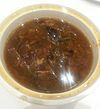 |
Mushrooms, noodles, and scrambled egg are common ingredients. People often add red vinegar to this soup. |
| Fried chestnuts
炒栗子 |
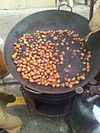 |
Chestnuts are cooked in a wok with black sand and sugar. |
| Egg waffles
雞蛋仔 |
 |
Made from eggs, sugar, and flour, then baked until golden. They are crunchy outside and soft inside. |
| Put chai ko
砵仔糕 |
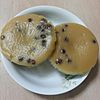 |
These are palm-sized puddings steamed in a porcelain bowl. |
| Stinky tofu
臭豆腐 |
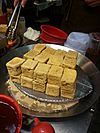 |
This tofu is deep-fried. It gets its stinky smell from natural fermentation. |
| Baked waffles
格仔餅 |
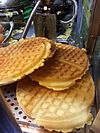 |
Two waffles are filled with peanut butter, butter, sugar, and condensed milk. |
| Beef offal
牛雜 |
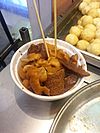 |
Braised beef offal, including parts like tripe and lungs. |
| Fried squid tentacles
炸魷魚鬚 |
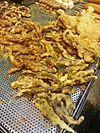 |
These are pickled until orange. They have a chewy texture. People often dip them in black vinegar. |
| Deep-fried pig intestine
炸大腸 |
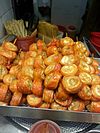 |
Cut into slices and put on a bamboo skewer. The outside is fried until orange. |
| Roasted sweet potatoes
煨蕃薯 |
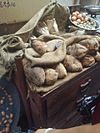 |
Soft and hot, these are perfect snacks for winter. |
| Three fried stuffed treasures
煎釀三寶 |
Stuffed eggplant, stuffed bell pepper, and stuffed bean curd. | |
| Traditional Candy and Coconut Wrap
糖蔥餅 |
A traditional Cantonese snack. It has hard sugar and coconut wrapped inside a white wafer slice. |


